
There is no one way to be productive — just as there is no one way to parent a child or roast a turkey. But there are terrible ways to do all three. And with each, you’ve got to have a basic understanding of the process before you begin.
I’m going to assume you have that — you know enough. For example, you recognize the following as a to-do list manager, and not, say, a rhinoceros.
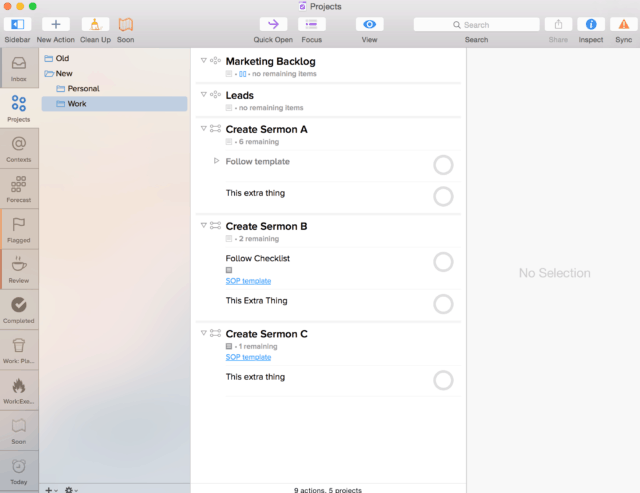
If not, you may want to take a look at some of our more basic articles on to-do list management here. You’ll also want to book an fMRI brain scan appointment with the closest neurologist you can find. Put a reminder to book the brain scan in your rhino so you don’t forget.
I’ll also assume that you are eager to improve your efficiency. You recognize that it matters, and you’ve kicked to the curb the dumb notion that only a few have been anointed with the ability to consistently start and complete important projects.
When it come to personal productivity, it’s really all the same. Getting Things Done (GTD), Agile Results, and Franklin-Covey all are there to help you:
- plan, do, review
- organize
- prioritize
- eliminate the unimportant
- focus on your most important tasks
- take care of yourself
- find momentum
- move toward your ideal
- achieve anything (but not everything)
- enjoy this life
- do more and be better
But systems often fall short. You may have tried GTD and noticed that:
- your to-do list just keeps growing
- you haven’t made much progress on your bigger goals
- you feel just as busy as before
Many people experience this. Despite being a GTD fanboy (proof, me gushing over the methodology while talking to its creator David Allen), I’ve talked with enough people to know that the system doesn’t work for everyone. That’s why I wanted to introduce you to fellow Asian Efficiency reader Nate. He transformed his life by following our Rituals system and the 12 Week Year by Brian P Moran.
Introducing Nate
Name: Nate Lowrie
Age: 30
Relationship Status: Married to Jamie Lowrie
Family Status: 4-year-old son Flint…another one on the way!
Location: Lebanon, PA, USA
Education: Engineering, Computer Science
Job: Dutch Valley Foods, IT
Business: Fineline Automation, sells routers that cut wood, plastic, and other materials based off of computer designs you create.
Nate’s been on a journey over the past year to improve his health, his wealth, and his mindset. It started in August of 2015 when Nate bought our Rituals course to improve his sleep. He used the Rituals System to install a morning and evening ritual. The routine gave his body the chance to fall into a rhythm that allowed Nate to catch up on years of sleep debt. With better rest and more energy, Nate’s progress continued when he joined the Asian Efficiency Dojo in October.
The Dojo was a type of community Nate did not have access to in his rural town. Many of his friends, coworkers, and family members were content doing things as they had always been done. They ate a standard American diet that lacked greens and overdid the carbs and processed food. They watched the (shockingly high) average amount of television. And they got the standard American results of obesity and living paycheck to paycheck.
Nate was inspired by his recent successes with Rituals and immediately became a leader in the new online community. He and other Dojos weren’t doing things the standard way. We were focused on continuous improvement by doing nonstandard things that produce the results we wanted.
Nate solidified his growth by posting new topics on what he was learning through books and personal experimentation. He encouraged others who were struggling with focus, low energy, or overwhelm. He gave tips and hacks he learned to be more efficient using technology. Then, on a whim, Nate decided to use the Dojo as a place to hold himself accountable. He did this by writing a journal entry that outlined his weekly goals. Nate also reflected on what went well, what went wrong, and what he intended to do the next week.
Nate posted this journal entry for all to see. The good and the bad.
The journal entry became a regular part of checking in with the Dojo. Watching the progress was inspiring. Seeing the struggles was sobering.
The journey continued. After finding success with Rituals and public journaling, Nate decided to fly to Austin for an Asian Efficiency mastermind where he wanted to get live, personal feedback on growing his business and improving his efficiency. The mastermind did two things for Nate and the other attendees.
First, it helped give direction. Ideas were brainstormed. Projects and actions were prioritized. A fresh set of eyes and ears were focused on current or potential blocks to attendees’ success. Nate’s hour in the mastermind hot seat gave him insights on how he could start to scale his business.
Then, after a delicious lunch at Lambert’s BBQ, we focused in on an implementation plan. Nate clearly saw his top three objectives. It was time to create an action plan that would get him to where he wanted to be.
He needed a system that went beyond GTD. Here’s what Nate did to:
- lose 14 pounds
- steal back 10 hours a week he was losing by working in his business
- increase his sales by 30%
Oh yeah. And Nate did all this in 90 days (12 weeks) thanks to the rituals he implemented and by following the 12 Week Year (more on that below)! But it wasn’t all sunshine. Nate first needed to remove all the things from his life that were holding him back.
Leakages
Nate has loads of strengths. He’s got an engineer’s mind. He’s capable of spotting a problem, drilling through the endless factors and details that encompass the issue, and developing a unique and viable solution.
Yet, Nate’s attention to the technical details was stagnating the growth of his business. Nate spent countless hours putting together router kits in his garage. These kits would be shipped off to customers. Many of these customers found assembly difficult. When they got stuck, they would email Nate for help. Because the emails were often difficult and time-consuming to answer, Nate would let them sit in his inbox for days, which was a big source of stress.
Selling a product that showed up with hours of assembly work to be done and then having to wait to get questions answered was not giving his customers the best experience. So Nate started taking two hours out of his already busy week to assemble the router as a short-term solution to his customer-support problem.
Diet
Nate also had another major leak: his diet. As a father, a full-time employee, and a business owner, there was often little time to consider how to eat healthy meals. Eating healthy was made even more difficult by an office environment that had unhealthy foods freely available in the break room. This made mindless snacking all too easy. Luckily, he found a really good solution to this problem (more on that later).
Execution Plan
The last, and most important, leak Nate had was with his execution. Nate didn’t have a system that focused all his talents in one direction. This is a problem we all face. The only real barrier standing between you and the life you’re capable of living is a lack of consistent execution. This is where our Rituals program came in.
Rituals
Nate started his transformation with Rituals – our system for implementing rock-solid habits and routines. He implemented both a morning and evening ritual.
He lays them out here.
Morning
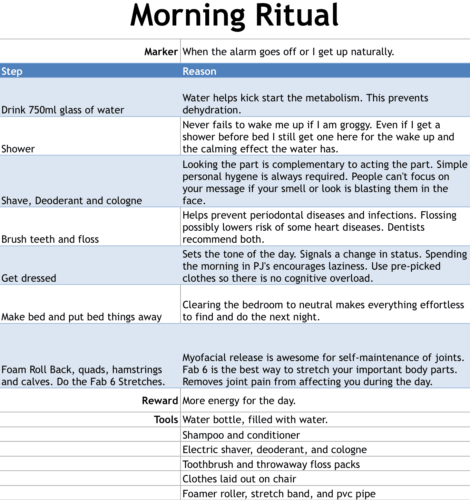
Evening
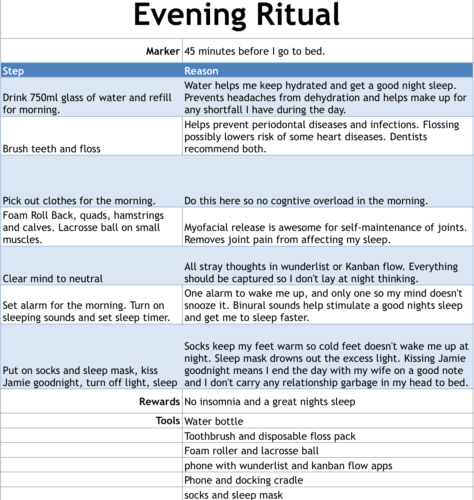
Nate had all the right ingredients for a strong ritual:
- a marker to set the ritual in motion
- an exact routine to follow
- a reward for completing the ritual
- a ritual tool list he could use when he needed to travel
This made Nate’s rituals fool proof. Any Joe or Jane off the street could flawlessly execute this plan. Taking the time to commit the ritual to writing 3x’s Nate’s likelihood of sticking with the habits over the long run. Having a strong ‘why’ behind each of the steps in his ritual and posting his rituals ‘wins’ and ‘losses’ weekly to the Dojo was the internal and external accountability that solidified his success.
Systems
Meal Prep
Nate and I connected for a 25-minute Rituals coaching call that came as a bonus to the course. During that coaching call, we talked about a diet-related ritual he had been wanting to put in place.
Nate had seen success with the Paleo diet in the past. This diet consists of mostly vegetables and meat. Nate and Jamie had grown up eating more standard American meals that included lots of sugar, dairy, grains, and other processed foods. They didn’t know how to efficiently execute the healthier diet they wanted to maintain. With little experience and no plan, frozen pizza often became last-minute dinner. While fast and easy, regular pizza nights were leading to negative long-term health consequences.
I told Nate about two services that I thought he would find useful to outsource some of the food prep he and Jamie didn’t have the time or energy to put in place. The first suggestion was called Prep Dish. Every month Prep Dish emails four to five weekly Paleo meal plans to Nate and Jamie. The plans have a shopping list and step-by-step meal prep instructions. The goal is to have most of your week’s meals bought, cooked, and packaged in a three or four-hour batch shopping, cooking, and cleaning session.
The second suggestion was a meal delivery service called InstaCart (that we are big users of). While InstaCart wasn’t available in Nate’s area yet, he was able to find a similar grocery delivery service called PeaPod. This easy system of meal plans and meal delivery opened up a great deal of mental bandwidth and time. It also made it significantly easier for Nate to implement the new diet that would give him the health goals he desired.
Kaizen
The next system Nate implemented to improve his life is called Kaizen. It’s a simple concept of continuous improvement (in fact, that’s the rough Japanese translation of the word). The idea can be distilled down into four words: fix what bugs you.
Nate’s always finding little improvements around his home and office. Here are three examples of inefficiencies that no longer bug Nate:
- replaced old measuring cups that had worn-out labels with a new set, so he had no more inaccuracies
- bought a physical inbox for paper capturing instead of constantly scrambling for papers
- upgraded the coffee mug to one with a lid that does not spill so he didn’t have to worry about his coffee and could instead focus on what actually mattered
The idea behind Kaizen is that all these little improvements will add up. To quote a musing from Nate’s weekly accountability journal entry:
“A few seconds here or a few seconds there doesn’t seem like a big deal. However, if you fixed 300 of these 2-second issues a year, that’s 600 second or 10 minutes a day save. Oftentimes, you will find solutions that save you HOURS of time. The more you do this, the more exponential the growth curve.”
Here’s a chart from webcomic XKCD that does a good job of visualizing how these efficiencies can add up.

The 12 Week Year
The last system Nate implemented at the beginning of 2016 was the 12 Week Year system by Brian P Moran. GTD wasn’t working for him, so we recommended that he try the 12 Week Year.
The 12 Week Year (12WY) is a system that has you plan and execute in 12-week periods of time. This was perfect for Nate, because he found that the shorter amount of time increased his urgency for taking action. When you only have 12 weeks to get something done, having one unproductive week is a major impediment. Even one day off point will hurt the chances of achieving your goals. It kept him focused on what was important.
Like GTD, the 12WY has you check in on a weekly basis. This weekly check-in isn’t the two (or more) hour marathon review of all your tasks. It’s a 30-minute review where you enter your implementation (or lack thereof) into a scorecard that lets you know if you are on track or falling behind. 85% or above is the goal.
You also make any adjustments necessary to next week’s plan. These tweaks are generally small, because you’ve already done the heavy lifting during the 12-week planning process.
He was finally able to follow a system that got him the results he was looking for: consistent action. At this point, our morning ritual helped him start the day, and with the 12 Week Year he was able to get his most important work done without much effort. Every week he would score his progress and make adjustments as needed. There was no longer a need for a long weekly review; the scoring system of the 12 Week Year is pretty quick, and it gives you actionable steps for what to adjust for next week.
(The irony is that the weekly review is the most important process in GTD but also the most neglected by people, because it’s time-consuming, it lacks actionable takeaways, and you can’t track how much progress you’ve made [which is demotivating]. If this resonates with you, then we highly recommend you try the 12 Week Year.)
Nate was nice enough to share his scorecard that he made in MS Excel. To get the scorecard, enter your name and email below, and we’ll send it right to you.
Nate's Scorecard Excel
Going Forward
Effective execution isn’t complicated, but it’s not easy either. It’s best if you can put yourself in a situation where taking the right action is as easy or easier than losing focus or burning out.
I was talking with my girlfriend last night. She was telling me about a point in her life when she was in the best shape of her life. It was senior year of high school. In the morning, before school, she had a weightlifting class. During the day she had color guard. In the afternoons and evenings, she had sports like volleyball. She also went to the beach frequently. The healthy choices were there. All she had to do was show up, and the results would take care of themselves.
So often we feel like it’s a lack of willpower or self-discipline that holds us back. But in reality, you could be the best version of yourself if you had a system that you could just jump into. Nate built that system for himself, and you can, too.
The ideas presented in this case study are just as available to you as they were to Nate. The only difference: Nate took action.
What Will You Do?
Deciding on one goal you’d like to achieve in the next 12 weeks is a great starting point. Write out a list of things you’d like to accomplish in your:
- Personal Finances
- Business
- Physical Environment
- Fun and Recreation
- Personal Growth
- Health
- Family & Friends
- Romance
- Philanthropy
Set a timer. Give yourself two minutes for each section. Don’t limit yourself. Imagine you’re a kid at Macy’s talking to Santa Claus. You just get to ask for that raise, that standing desk, that accreditation, that sales number, that date night…
18 minutes later, look at the list. What are you most drawn to? What’s an area that could pull other areas up? Take two more minutes to list all the reasons why it would be incredible to accomplish that goal.
Here’s a personal example:
- Personal Growth: I want to be a competent communicator at Toastmasters within one year.
Speaking is the way I best communicate. I get energized by it. I feel like I could energize other people with my words and presence. To grow this area would allow me to make a bigger impact with whatever message I am passionate about at the moment (they are all typically around helping people set up systems to live more effective and happy lives).
Then use metrics to make sure you’re on track. Mine are simple:
- Attend all 10 Toastmasters meetings I’m in town for.
- Write and deliver three speeches.
Download the scorecard now. These 25 minutes could change your life.

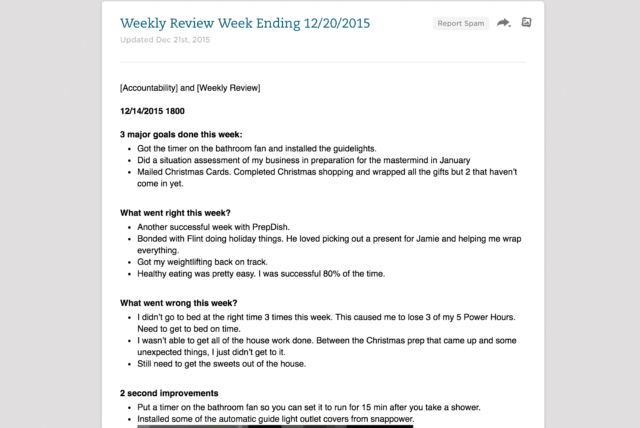
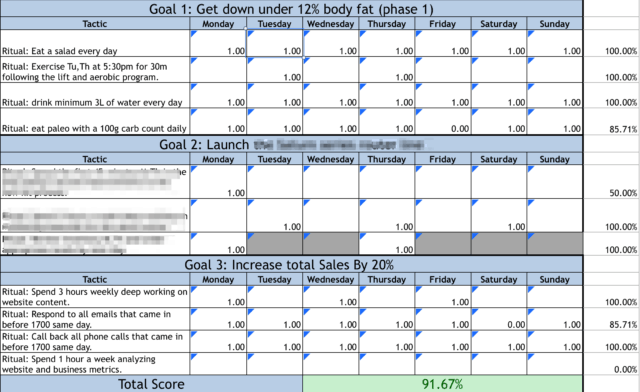

Fantastic insights I can immediately put to work during this first week of my 12wy. I have two goals – first to finish “Yellow Brick Road,” a guide to navigating the pavilions & hallways of two hospitals to arrive at a patient room.
Second to guide regional cancer center personnel in adopting productivity and automation “best practices” that improve care workflows and patient convenience & satisfaction.
Thank you, Zack, for this concise “how-to” get started defining a path to being effective in life.
Respectively,
Kel
I see how the 12 week year is tracked in the spreadsheet.
How about the morning and evening rituals? Are they still tracked and if so would they be tracked differently than the goals. Or could they too be considered a goal?
Hi Team,
Reading Nate’s story a few months ago inspired me to bite the bullet and start a 12WY. (Thanks Zachary and Nate!)
I’ve written up my experience for anyone interested – check it out at https://productivephysician.com/achieve-goals-12-week-year/.
Have a productive day!
Mark
If your GTD Weekly Review takes you more than an hour, you might try adjusting your WR checklist. That worked for me.
Congratulations to Nate on his 12WY successes, and thanks very much for sharing morning & evening rituals and the scorecard. My first 12WY goal is to create and implement my own rituals so I have more time and energy to devote to other endeavors!
I am still struggling to create a morning ritual that really works but doesn’t take hours. “Fab 6” seems interesting. What is it?
Great article with great insights.
I have a ritual for the morning, but I never had any yet for the evening. After reading this, my mind was racing to come up with my evening ritual.
Thank you for sharing. :)
This is fantastic! So inspiring. Thanks for posting and thanks to Nate for sharing his story.
As always very informative and most certainly adds value to anyone trying to create a more productive day and life.
I do love a good success story! well done Nate! Is this system taken from the book, ‘The 12 week year’?
Hello,
i was read this text and this is very helpfull. I was use sou guide to Omnifocus 2, its great too. now i have question. Do you have some training, or source where do you speaking about work life balance problematic? How to combine work + life vision, goal and task.
Thank for information, Boris